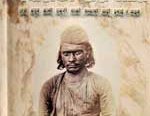
Dr. Bipin Adhikari’s Nepal ka Khas Jaati is an informative booklet that sheds light on the might as well as the plight of one of the most prominent tribes in Nepal, the Khas tribe. The booklet is well researched and contains historical accounts from various early as well as modern European, Indian and Nepali historians. It is easy to read and provides a straight forward account of the historical events.
Originating from modern day Central Asia, the Khas people are said to have migrated from their ancestral land towards the Himalayan region of southern Asia (Kashmir, Himachal Pradesh, Uttarakhand and Nepal) in ancient times. The modern day Khas include Chhetri, Bahun, Kami, Thakuri, Sarki, Sannyasi, Badi, Damai, Gaine and others. According to the author, the period of their migration remains ambiguous and stretches back to the pre-christ era. In Nepal, the Khas people first settled around present day Karnali region. The Khas kings formed the famous Malla Kingdom, which ruled Khasan (Jumla) from the eleventh century before collapsing and splintering into local dominions during the fourteenth century.
In this booklet, Dr. Adhikari seeks to debunk a lot of popularized myths about the Khas people. One such myth is that they migrated to Nepal from India to evade the Muslim tyranny. Historical sources have confirmed that this is in fact not true. The existence of Khas people in the Nepali region dates back well before the time of the great Mogul empire in the south. It is accepted that some Brahmins did flee to Nepal, during Mogul regime, and started enforcing the caste system in Nepal. In that regard, some Bahuns today are probably descendents of these Indian refugees; however, the vast majorities are still Khas people.
Also, Dr. Adhikari sheds light on the significant influence Khas people have had on the cultural traditions of Nepal. Practices such as Dheusi, Bhailo are common place in Nepal. These practices are a result of the Khas influence. The prevalent tradition of the oracle, Dhami, is another practice synonymous with Khas traditions. Moreover, the Khas language, modern day Nepali, became the national language when the Shah dynasty of Gorkha unified the splintered Himalayan region into modern Nepal.
Further, Dr. Adhikari takes us on the journey of the evolution of Khas tribes from un-civilized nomadic tribes to the civilized classes of Nepal. The prominent roles of Hinduism and Buddhism have been mentioned here. Further, Dr. Adhikari stresses the benevolent nature of Khas assimilation in Nepali demographic. The cultural exchanges between the Khas and non-Khas have been emphasized in many occasions. Similarly, the adoption of Hinduism and Buddhism, and the conservation of religions heritages have been highlighted during the regimes of Kra Challa, Ashok Challa and Punya Malla.
Moreover, Dr. Adhikari elucidates some of the misconceptions about the Khas origins. He argues that the negative depiction granted to them in the religious Hindu texts such as Mahabharat, as barbarous savages, has had a profound impact on their status. According to him, the lower status of Khas people prescribed by the holy Hindu scrolls, led the early rulers, such as Ram Shah, to falsely claim their ancestral origins when in fact they were none other than the descendants of the nomadic Khas from Eurasia. Further, the introduction of the class system through the Indian influence caused native Khas Bahuns and Chettris to denounce their Khas origins in order to claim a greater status in class hierarchy. Prior to Indian influence, the Khas societies did not have any class structure. In this regards, the author professes that assimilation to Hinduism and Buddhism, despite contributing a great deal in their adaptation to the region, caused the Khas people to lose a lot of their cultural legacy. As a result, majority of Khas descendants today are misguided in accepting their ancestral recognition.
Subsequently, Dr. Adhikari highlights the role of Khas in the unification movement during the Shah era and their subsequent significance to maintenance of Nepalese sovereignty, especially in light of glooming threats in the north and the south. The book is a valuable piece of work that disproves a lot of arguments floating around instigating identity politics in Nepal. The mere fact the Khas people (Bahuns, Chettris, etc) have been inhabitants in modern day Nepal for centuries stakes their equal claim in the restructuring process. The booklet claims that the Khas are as indigenous to Nepal as the Kirants, Bhotiyas and Janajatis. However, read more closely, the book, in enlightening the readers about the evolution of Khas settlement in Nepal, provides a valuable lesson to the future inhabitants.
The Khas tribes came into Nepal; inhabited lands peacefully, respected other tribes, their traditions and also accepted the popular religion of the region. This is a quintessential element of a benevolent tribe. Their nomadic lifestyle, warrior built and Himalayan work ethic condemned them to the footnote of Hindu class structure. Nevertheless, Nepal owes a debt of gratitude to the Khas tribes that inhabited these lands. In fact, there is a lot to learn from them as well. This booklet is indeed a good place to start.
- COVID -19 And The Rule Of Law In Nepal
- Sep 03, 2020

















